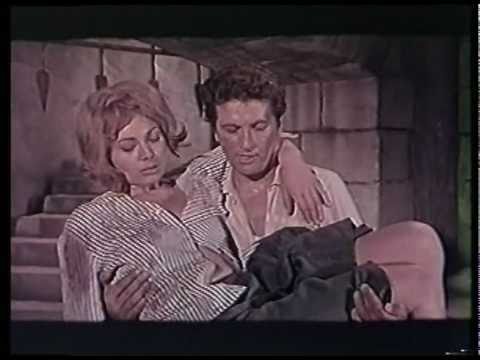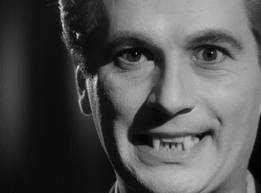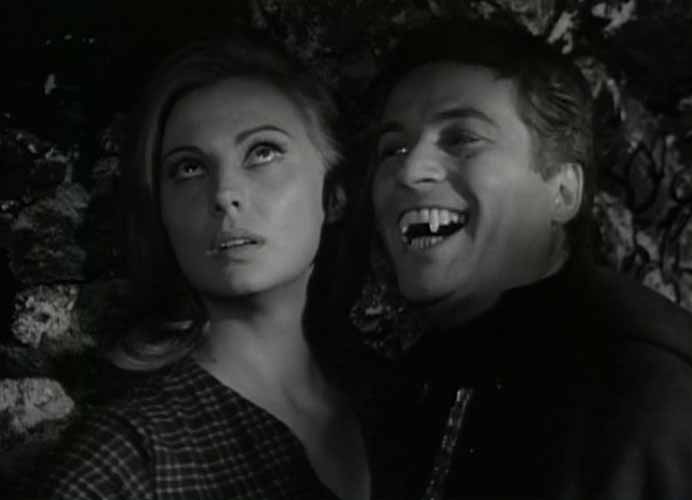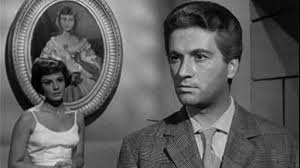
Just who was Walter Brandi? Well, to some people he’s best known as an Italian b-movie star of the early sixties, a solid if not particularly inspiring presence in numerous gothic horror films and historical adventures. But in the Italian film industry he’s probably better known as the producer, often using the pseudonym Walter Bigari, who was behind numerous successful, low budget releases throughout the 1970s and 80s. Zombie Creeping Flesh? That’s one of his. Scalps? That one too. Also Aenigma, Getting Even, Miami Cops and many, many others. Most of these were solid video shelf fillers, some of them took off an were worldwide hits. Just about all of them are of interest to cult film fanatics. His film career began with a couple of uncredited roles in big budget peplums, Carmine Gallone’s Messalina (51) and Mario Camerini’s Ulysses (54). He appeared in another half dozen films throughout the 1950s, with the size of his roles gradually increasing. More importantly, he made contacts: Sergio Bergonzelli was an uncredited actor on Messalina, Roberto Mauri the star of Retaggio di sangue (56), Erno Crisa and Amedeo Trilli, both of whom would work repeatedly with Brandi, were his co-stars in Due selvaggi in corte (59).

By this time, he’d fallen in with a group of actors and directors who would often appear in each others films, almost like a cinematic workshop: Mauri, Luigi Batzella, Alfredo Rizzo, Giuseppe Vari, Renato Polselli. In the early sixties, Brandi became their leading man of choice, despite – in all honesty – not really having the screen charisma to justify such a lofty position. It’s not that he was a bad actor, he was passable if not particularly talented, but he’s often a somewhat heavy presence in these films, without much in the way of warmth of likability. sometimes this works, sometimes not. Anyway, during the early part of the decade he made numerous films in varying genres. He starred in a couple of early crime films, Mauri’s I mafiosi (59) and Edoardo Mulargia’s Le due legge (62), both of which co-starred Erno Crisa. Le due legge is particularly interesting, a proto-spaghetti western filmed in Sicily with a largely unprofessional cast, in which he plays a vengeance crazed farmer out to track down and kill the man (Crisa) who killed his brother.

There were also numerous historical adventures. Il segno del vendicatore (62) was a Zorro film in which he had a small supporting role, Flag of Death (63) an entertaining enough pirate movie in which he was the foil to star Richard Harrison, Zorikan the Barbarian (64) a Saracen movie starring Dan Vadis and Three Swords from Rome (64) an Ancient Roman adventure with Roger Browne and Mimmo Palmara. All of these were directed by Roberto Mauri, a director who was expert in eking out decent product from limited budgets. His films might not be masterpieces, but they’re more than serviceable, and he was certainly a more talented filmmaker than either Angelo Dorigo or Piero Regnoli, with whom Brandi made a couple more swashbucklers, La grande vallata (61) and The Hawk of the Caribbean (62). More often than not he was relegated to supporting roles in these films, giving center stage to more athletic performers such as Johnny Desmond, Harrison or Browne and playing villains of one type or another. Brandi is undoubtedly best known, however, for the performances he gave in the six horror films he made between 1960 and 1965, making him something of the Italian equivalent of a Christopher Lee… or maybe Anton Diffring… or maybe Mike Raven. The first of them, The Vampire and the Ballerina (60) was directed by cult filmmaker Renato Polselli and established the template for many of the low budget horror films that were to follow: a group of sexy dancers and their slightly comic manager end up in an isolated village near an ornate but run down castle where they come across an ageing countess (Maria Luisa Ronaldo) and her dubious servant (Brandi), both of whom are vampires. Needless to say, much blood-sucking and low-key eroticism ensues. Polselli’s films were always made with limited means, but this is one of his best and looks pretty good for its restricted means. But that didn’t prevent it from experiencing distribution problems and it wasn’t released until 1962. In the meantime, Brandi starred in Piero Regnoli’s The Playgirls and the Vampire (60), which featured – stop me if you’ve heard this before – a group of sexy dancers and their slightly comic manager ending up in an isolated, ornate but run down castle, where they come across a strange Count (Brandi) who might or might not be a vampire. Then there was another film for Roberto Mauri, The Slaughter of the Vampires (62), in which Brandi and Graziella Granata play a pair of newlyweds who fall under the spell of a sinister stranger (Dieter Eppler), who might or might not be a vampire and another Renato Polselli film The Vampire of the Opera (64), in which a group of sexy actresses end up in an ornate but run down theatre where they come across a strange aristocrat who’s definitely a vampire.

If all of these films seem similar, well… they are. But Brandi’s final two horror films were slightly different. Terror Creatures from Beyond the Grave is an extremely enjoyable slice of gothic horror from Massimo Pupillo, in which Brandi plays a lawyer paying a visit to a country village after being summoned to draw up a will for a doctor who lives there. Only trouble is that the doctor’s been dead for a year, people are dying all over the place and apparently some ghosts of evil sorcerers are terrorizing everyone who is still alive. He re-teamed with Pupillo for the Bloody Pit of Horror, which returned to more familiar lines by featuring a group of sexy models and their slightly comical manager who end up in an ornate and run down castle where they come across a reclusive actor (Mickey Hargitay) who might or might not be a crazed muscleman dressed in a Zorro mask and with a personalized torture chamber who is known as ‘the Crimson Executioner’. Ok, so the plots pretty much the same as Brandi’s earlier film, but this is crazy stuff, hugely enjoyable, and Brandi wears a nice cardigan while playing the hero. There were two final films before Brandi gave up his acting career. Island of the Lost Girls (69) saw him play the ‘secret’ head of a white slave ring in a late entry in the successful Kommissar X series of films starring Tony Kendall and Brad Harris and there was a small role in Bruno Mattei’s Private House of the SS (77). But by this time he was concentrating his efforts behind the camera. In fact, he’d been producing films since 1964, when he worked behind the scenes on Zorikan the Barbarian. Before long, he was working on films he didn’t also star in, although many of them were directed by previous collaborators: A… come assassino (66) and Un colpo da re (67) for Angelo Dorigo; Eva, la Venere selvaggia (68), Wanted Sabata (70) for Roberto Mauri. It was in the 1980s that he became better known as a producer, partially because most of the makers of low budget, populist entertainment – people like Fortunato Misiano – had fled the industry. Using the pseudonym Walter Bigari and often under his A.M. Trading International company, he was one of the few producers who was still prolific enough to become a familiar name, along with the likes of Joe D’Amato and Fabrizio De Angelis.